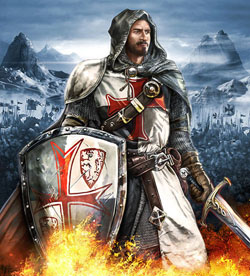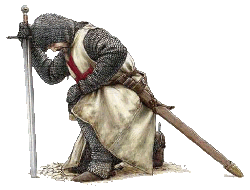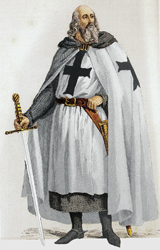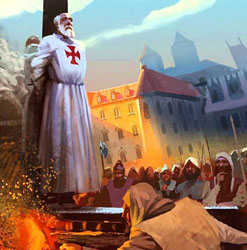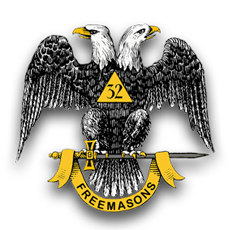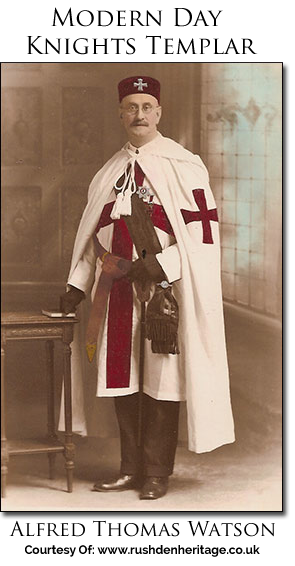The Masonic Knights: Free Masonry and the Knights Templar
The Freemasons and the Knights Templar have an enchantingly mysterious, yet historically factual intersecting history. There are many myths and legends surrounding us Freemasons and the Holy Order of the Knights Templar and in this edition of Digital Parchment we explore those myths and legends and try to shed some light on the relationship between the Freemasonry today and the Knights Templar.
The Knights Templar were first founded in 1119 by the French nobleman Sir Hugues de Payens. Sir Hugues believed that God had called him to assemble an Order of Holy Knights to protect pilgrims and carry out his will in The Holy Land. In 1120 at The Council of Nablus, King Baldwin II of Jerusalem approved the founding of the order and allowed them to establish their headquarters in a wing of the royal palace on the Temple Mount in the captured Al Aqsa Mosque. The Temple Mount is the holiest site in Judaism which according to the rabbinic sages whose debates created the Talmud, it was from here that the world expanded into its present form. They believed that from this location God himself gathered the dust used to create the first human, Adam. The Al Aqsa Mosque is also believed to have been built on top of the ruins of the Temple of Solomon. The Crusaders therefore referred to the Al Aqsa Mosque as Solomon’s Temple and The Poor Fellow-Soldiers of Christ at of the Temple of Solomon were born; better known as The Knights Templar.
For 200 years the Holy Order of the Knights Templar protected Christian pilgrims traveling to Terra Sancta, The Holy Land of Jerusalem, fought alongside King Richard The Lion Heart in the Third Crusade and founded many aspects of modern banking. They bore so many resemblances to the Operative Freemasons of the day some historians speculate that they were really one in the same. One of the most commonly accepted theories is that Operative Masons were financially tied to the Templars because Operative Freemasons were needed to build the many fortresses and castles established by The Templars in the holy lands. Even some of the lexicon between the two orders is similar which leads historians to believe that Freemasons were Templars and that Templars also belonged to the Operative Guilds of Freemasonry as sponsors and financial backers. The mounted Templars at arms represented the most common class of Templar Warrior and they were commonly called “Brothers” as Speculative Freemasons today address each other. Perhaps one of the most striking similarities between Freemasons and Templars is their ability to move around the countryside unobstructed. They were also exempt from taxes and local laws, just as Operative Masons of the day were “Free” to move about the land and exempt from taxes and local laws. In 1139 this power was officially conferred upon the Templars by Pope Innocent II, who issued the papal bull, Omne Datum Optimum. It stated that The Knights Templar could pass freely through any border, owed no taxes, and were subject to no one’s authority except that of the Pope. Only Operative Masons shared the same privileges and freedom of movement.
Templars utilized the banking practices of the Freemasons to fund their campaigns which were extremely costly due to the high mortality rates of medieval battle. In 1244, at the battle of La Forbie only 33 of the 300 Knights Templar survived and it is estimated that the financial loss was equivalent to one-ninth of the entire Capetian yearly revenue. Freemasons had guild halls and operations all over the world and often gave sanctuary to the “Brothers” of the Knights Templar. The Templars also suffered ridicule and criticism during their later years for partaking in strange rituals and practices, possibly the rituals of Freemasonry as more and more Templars were likely inducted into Operative Guilds. The Freemasons had the wealth, the operative guild halls and the exemption from local principalities to allow the Templars to move about the land and carry out their missions. This is one major reason why historians believe that the Templars associated themselves with and later merged with the Operative Guilds of the Freemasons.
The Templars and Freemasons also had many of the same benefactors and supporters. Every kingdom in Europe needed the Operative Masons to construct their temples, glorious cathedrals, castles and fortifications. Kings and Popes financially backed the Operative Masons and these Masons seemed to be exempt from the deadly politics that killed tens of thousands during the warring middle ages. Saint Bernard of Clairvaux, nephew of one of the original nine founders of the Knights Templar, one of the leading supporters of Pope Innocent II and a revered churchman of the time wrote a multi-page dissertation entitled De Laude Novae Militae “In Praise of the New Knighthood“. In it he supported the Templars and defended the idea of a military religious order by appealing to the long-held Christian theory of Just War, which legitimated taking up the sword to defend the innocent and the Church from attack. By writing the De Laude Novae Militae and backing the Templars, Bernard succeeded in legitimizing them within Christianity and the Templars became the first warrior monks of the western world.
One large distinction between the Templars and the Operative Masons was that fact that Templars were a religious military organization while the Freemasons were not. Existing not necessarily in the shadows but outside of society, the Freemasons were a threat to no one. In fact they were a necessity because without Masons, European Nobility and The Church couldn’t build their great castles and cathedrals. Some speculate that the Masons held a protected status which the Templars could not sustain as a military organization. The Templars began their fall into disfavor on July 4, 1187 after the disastrous Battle of the Horns of Hattin, a turning point in the Crusades. The Templars lost this battle to General Saladin, supreme commander of the Muslim forces in the Holy Land who they had traditionally defeated in previous battles. Gerard de Ridefort Grand Master of the Order led the Templars on several foolish campaigns which ultimately cost Europe the holy city of Jerusalem and The Templars as a whole were blamed. They went on to restore some favor in their battles with King Richard the Lion Heart who eventually retook the Holy City but after the Siege of Acre in 1291, the Templars were forced to relocate their headquarters to the island of Cyprus when they lost the territory to the Muslims.
1292 Enter Jacques de Molay
By this time the Templars had strategically interwoven themselves into the Masonic Guilds and some sources say that Jacques de Molay, last Grand Master of the Templars was also the Grand Master of the Freemasons.
According to one source, “After going underground to escape the Inquisition, the Templars infiltrated various other sects and organizations. For their purposes, the masons’ lodges were an ideal choice. Very quickly, they infiltrated them, brought them under their own control, adapted and altered them to accommodate the Templars’ own philosophy, beliefs, and rituals. Since they had long been trained in the arts of architecture and masonry and had gained expertise in building castles and Gothic Cathedrals, it was easy enough for the Templars to infiltrate and control the professional guilds of masons. Published reference works by Masons refer more often to the symbolic features of their merger with the Templars, than to the darker aspects the Masons inherited from them.
As one Turkish Masonic source writes:
The Grand Master’s abacus [staff of office] is evidence for the connection between the Templars and Freemasons. This staff is a symbol representing Aaron’s rod [mentioned in the Bible – a walking stick that sprouted leaves]. Its head is in the form of a temple, and along length of its body is carved measurements. This staff is a symbol of masonry.
In France as well as in Jerusalem, Templars and Freemasons existed side by side and must have influenced each other’s esoteric knowledge. An examination of architecture when the Gothic style came to be adopted reveals that the first European churches built deliberately in the new Gothic style began to be constructed after Jerusalem’s conquest by the crusaders.
With the Templars’ Grand Master being also the Freemasons’, it can be observed that the gradual progress from Operational Masonry to Speculative Masonry had already begun. The Cistercian monks, dealing with construction planning, had also been members of masons’ lodges-an example to the clerical or monastic type of mason; In Paris, where all other professions had their own lodges, the masons shared quarters with the Templars, also showing the close relationship between the two organizations.
It would seem that the fates of the Templars and Freemasons were thickly intertwined. The Papal decree of 1312 (Bull Vox in Excelsis) that dissolved the Templars’ order also ended the Masons’ right of free passage. When Pope Clement V declared the Bull Vox in Excelsis he stated that although there was not sufficient reason to condemn the Order, for the common good and the hatred of the Order by Philip IV, the Order was to be disbanded on the pope’s authority. The order explicitly stated that dissolution was enacted, “with a sad heart, not by definitive sentence, but by apostolic provision.” The papal process started by Pope Clement V, to investigate both the Order as a whole and its members individually found no knights guilty of heresy outside of France. Fifty-four knights were executed in France by French authorities on the orders of Philip IV as heretics after denying their original testimonies before the papal commission. These executions were motivated by Philip’s desire to prevent Templars from mounting an effective defense of the Order and even though the Knights were tortured to produce their confessions, when questioned by the Papal commission they continued to denied the charges of Heresy.
Some Templar branches weren’t affected nearly as much by the Papal Order which brought an end officially to the Templars. For example, The Military Order of Christ Ordem Militar de Cristo was the former Knights Templar order in Portugal but after the suppression of the Templars in 1312 they simply reincorporated in 1318 under a new name. Under the protection of the Portuguese King Dinis I who refused to pursue and persecute the former Templars, the new order flourished and still exists today.
The Scottish Rite and the Knights Templar
(We consulted outside sources listed at the bottom of this blog for the additional following information. Italicized paragraphs are composed of content belonging to outside sources).
The Scottish rite of Freemasonry, oldest of the Masonic lodges employed to provide shelter for the Templars, was established in the 14th century by Templars seeking refuge in Scotland. It became an example for the rest to follow. The titles of the Scottish lodges’ highest ranks continue to be identical to those given to the Knights Templar centuries before. Baron Karl von Hund, one of the most famous Masons of the 18th century who compiled research on the Templars, called the Scottish lodges a “restoration” of the Templars. According to him, eight prominent Templars fled first to Ireland and thence to Scotland, where they reorganized. The Templars were soon active again in many other countries, but Scotland became their new stronghold, where they based their operational headquarters.
Baron Karl von Hund, the creator of the grade of Masonry known as the Rite of Strict Observance [was responsible for adding the Templar legend to the Craft]. Von Hund’s Rite of Strict Observance spread throughout Europe including parts of Switzerland and even as far as Russia. There is no doubt that the Order of the Temple, the highest of the Chivalric Orders in the York Rite, and the Knight Kadosh grade of the Scottish Rite owe a great allegiance to the legend first put forth in Von Hund’s Rite of Strict Observance.
In the following centuries, Masonic Templarism branched out, expanding around the world to become a serious global power, while always remaining true to its Templar ideology: In 1717 “accepted Masons,” working in operative lodges, decided to create for themselves an organization to provide them tolerance and freedom of thought within the religious, political and ideological environment of the 18th century.
Baron Karl von Hund, the creator of the grade of Masonry known as the Rite of Strict Observance [was responsible for adding the Templar legend to the Craft]. Von Hund’s Rite of Strict Observance spread throughout Europe including parts of Switzerland and even as far as Russia. There is no doubt that the Order of the Temple, the highest of the Chivalric Orders in the York Rite, and the Knight Kadosh grade of the Scottish Rite owe a great allegiance to the legend first put forth in Von Hund’s Rite of Strict Observance.
Outside Sources:
http://www.bibliotecapleyades.net/sociopolitica/templars/knights_templars02.html
The Templar of Tyre, Gestes des Chiprois, p.104 / part 3
Teoman Biyikoglu, “Tampliyeler ve Hurmasonlar” (Templars And Freemasons), Mimar Sinan, 1997, no. 106., p. 19.
“The ‘Templar of Tyre’: Part III of the ‘Deeds of the Cypriots’”, by Paul Crawford, p.171 (Google Books limited preview); which gives a translation with notes of the chronicle of one of the Knights Templar who apparently recorded these things during the later retreat to Cyprus.
Michael Baigent, Richard Leigh, The Temple and the Lodge; http://mailbox.univie.ac.at/~muehleb9/stinvention.html
Hikmet Murat, “Turkiye’de Masonlugun Kurulusu” (The Foundation of Freemasonry in Turkey), Mimar Sinan, year 4 (1974), no. 14, p. 25.
“The Knights Templar | In Praise Of The New Knighthood”. www.templarhistory.com. Retrieved 2011-06-13.
Malcolm Barber, The Trial of the Templars, 2nd edn. (Cambridge, 2006), pp. 2, 217–58;
Mirabeau, Histoire de la Monarchie Prussienne, V. 76, quoted in Secret Societies, Nesta H. Webster, Boswell Publishing Co., Ltd., London, 1924.
Lecouteulx, de Canteleu, Les Sectes et Sociétés Secrètes, p. 97, quoted in Nesta H. Webster, Secret Societies, Boswell Publishing Co., Ltd., London, 1924.





